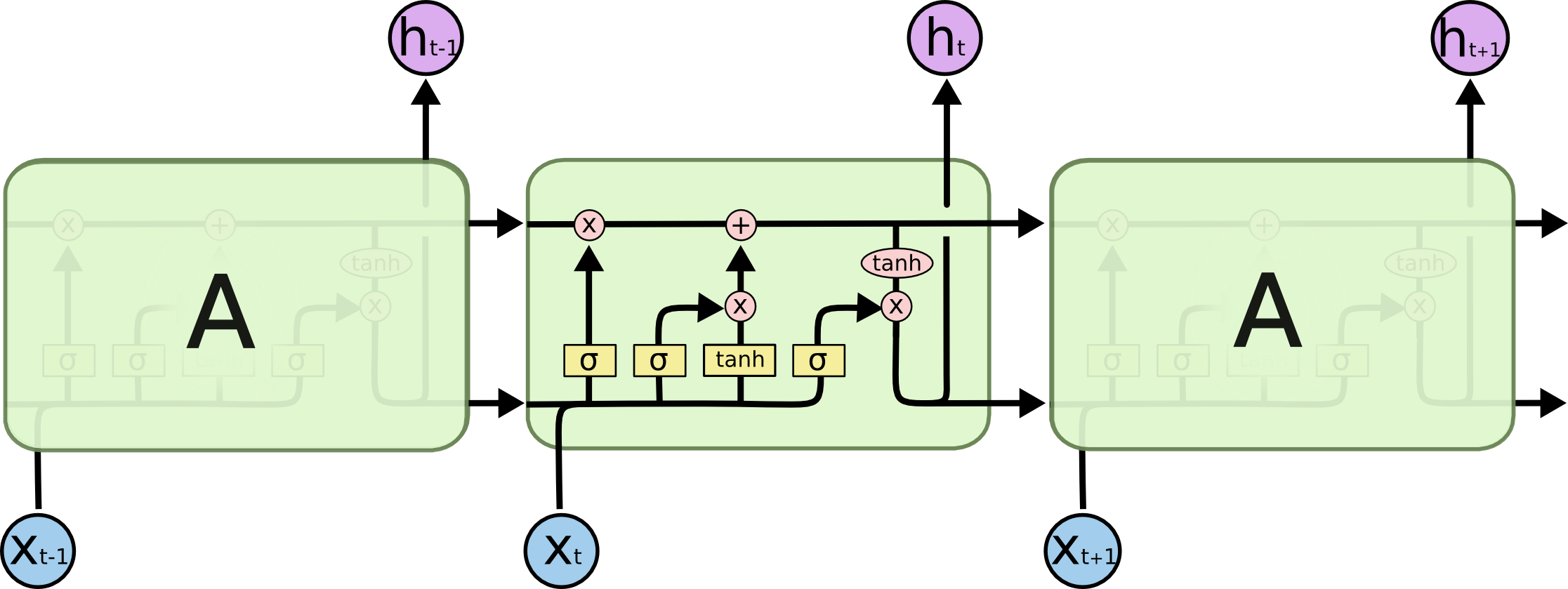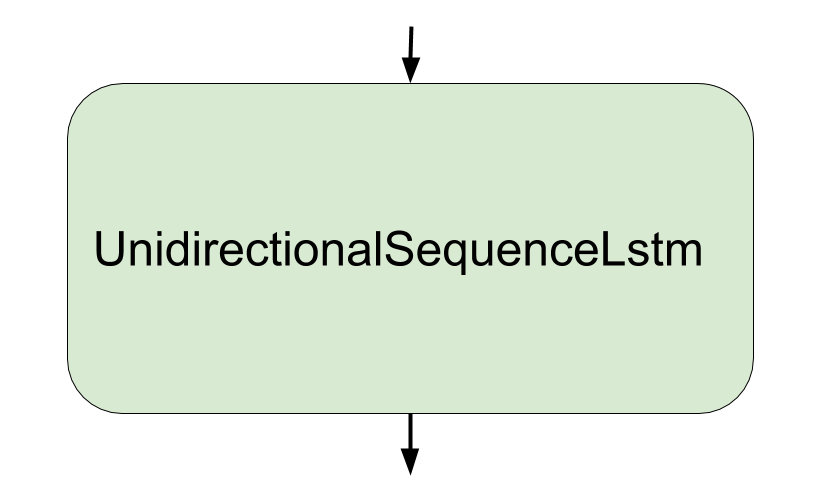TensorFlow Lite LSTM ops API
TensorFlow Lite LSTM ops help developers deploy LSTM models to TensorFlow Lite. This is currently an experimental API, it's likely to change in future.
Introduction
LSTM ops in TensorFlow Lite realm are expressed as "fused ops" (e.g.,
UnidirectionalSequenceRNN, BidirectionalSequenceLSTM, etc.). However, in
TensorFlow, LSTM ops are expressed as a "cell" (e.g., tf.nn.rnn_cell.LSTMCell,
tf.nn.rnn_cell.BasicRNNCell, etc., and they all contain multiple TensorFlow
ops) and a "rnn" ( e.g., tf.nn.static_rnn,
tf.nn.bidirectional_dynamic_rnn).
The ops breakdown in TensorFlow gives us flexibility while the "fused op" in TensorFlow Lite gives us performance boost.
See the difference between TensorFlow LSTM and TensorFlow Lite LSTM.
TensorFlow LSTM op ("cell")
TensorFlow Lite LSTM op ("fused ops")
The TensorFlow LSTM figure is credited to this blog.
How to use
To use TensorFlow Lite LSTM ops is actually pretty simple.
1) Training & Evaluation.
First step is replacing tf.nn.rnn_cell.LSTMCell with
tf.lite.experimental.nn.TFLiteLSTMCell in training phase, and replacing
tf.nn.rnn.dynamic_rnn with tf.lite.experimental.nn.dynamic_rnn, if you are
using dynamic_rnn. Note you don't need to change if you're using static_rnn.
Both tf.lite.experimental.nn.TFLiteLSTMCell &
tf.lite.experimental.nn.dynamic_rnn are just normal tf.nn.rnn_cell.LSTMCell
and tf.nn.rnn.dynamic_rnn with OpHinted nodes in it to help the graph
transformation.
Then you can train and export the model as usual.
2) Export for TensorFlow Lite inference as usual.
When you want to convert to TensorFlow Lite model, you can simply get the session, then convert to TensorFlow Lite model.
Then you can convert the model to TensorFlow Lite model as usual.
converter = tf.lite.TFLiteConverter.from_session(sess, [INPUTS], [OUTPUTS])
converter.post_training_quantize = True # If post training quantize is desired.
tflite_model = converter.convert() # You got a tflite model!
Simple example diff for using original TF code VS. TensorFlow Lite code:
@@ -56,7 +56,7 @@ class MnistLstmModel(object):
for _ in range(self.num_lstm_layer):
lstm_layers.append(
# Note here, we use `tf.lite.experimental.nn.TFLiteLSTMCell`.
- tf.nn.rnn_cell.LSTMCell(
+ tf.lite.experimental.nn.TFLiteLSTMCell(
self.num_lstm_units, forget_bias=0))
# Weights and biases for output softmax layer.
out_weights = tf.Variable(tf.random.normal([self.units, self.num_class]))
@@ -67,7 +67,7 @@ class MnistLstmModel(object):
lstm_cells = tf.nn.rnn_cell.MultiRNNCell(lstm_layers)
# Note here, we use `tf.lite.experimental.nn.dynamic_rnn` and `time_major`
# is set to True.
- outputs, _ = tf.nn.dynamic_rnn(
+ outputs, _ = tf.lite.experimental.nn.dynamic_rnn(
lstm_cells, lstm_inputs, dtype='float32', time_major=True)
Why introduce another set of LSTM APIs?
Bridging TensorFlow LSTM and TensorFlow Lite is not easy, and the use of
dynamic_rnn adds additional complexity (as the while loop is introduced).
With the help of
OpHint
(also see the next section), we create special wrappers around rnn_cell and
rnn to help us identify the inputs and outputs of the LSTM ops, and these
ops are converted to a single fused LSTM op when converting TensorFlow models
to TensorFlow Lite format.
What's OpHint
OpHint is essentially Identity op that is inserted after input tensors and
output tensors to "hint" the customized op boundary, see the following figure.
Ophinted Customized Graph
Let's say we have a "customized conv" op which is a normal conv2d op with a bias
add op followed by an activation op (graph on the letf), we use OpHint to
track down all the inputs and output, during the graph transformation phase
(done by tf.lite.experimental.convert_op_hints_to_stubs), the conv2d op, bias
add op and the activation op will become a "my customized conv" op (see the
graph on the right), and all the "OpHinted" tensors will become the
inputs/outputs of the "my customized conv" op.
Simple Tutorial
The following tutorial uses MNIST dataset to build a simple two-layer LSTM model and convert to quantized TensorFlow Lite model.
Note since we will be using dynamic_rnn, we need to turn on control_flow_v2.
0. Turn on control_flow_v2.
# Note this needs to happen before import tensorflow.
import os
os.environ['TF_ENABLE_CONTROL_FLOW_V2'] = '1'
1. Build the model.
class MnistLstmModel(object):
"""Build a simple LSTM based MNIST model.
Attributes:
time_steps: The maximum length of the time_steps, but since we're just using
the 'width' dimension as time_steps, it's actually a fixed number.
input_size: The LSTM layer input size.
num_lstm_layer: Number of LSTM layers for the stacked LSTM cell case.
num_lstm_units: Number of units in the LSTM cell.
units: The units for the last layer.
num_class: Number of classes to predict.
"""
def __init__(self, time_steps, input_size, num_lstm_layer, num_lstm_units,
units, num_class):
self.time_steps = time_steps
self.input_size = input_size
self.num_lstm_layer = num_lstm_layer
self.num_lstm_units = num_lstm_units
self.units = units
self.num_class = num_class
def build_model(self):
"""Build the model using the given configs.
Returns:
x: The input placeholder tensor.
logits: The logits of the output.
output_class: The prediction.
"""
x = tf.placeholder(
'float32', [None, self.time_steps, self.input_size], name='INPUT')
lstm_layers = []
for _ in range(self.num_lstm_layer):
lstm_layers.append(
# Important:
#
# Note here, we use `tf.lite.experimental.nn.TFLiteLSTMCell`
# (OpHinted LSTMCell).
tf.lite.experimental.nn.TFLiteLSTMCell(
self.num_lstm_units, forget_bias=0))
# Weights and biases for output softmax layer.
out_weights = tf.Variable(tf.random.normal([self.units, self.num_class]))
out_bias = tf.Variable(tf.zeros([self.num_class]))
# Transpose input x to make it time major.
lstm_inputs = tf.transpose(x, perm=[1, 0, 2])
lstm_cells = tf.keras.layers.StackedRNNCells(lstm_layers)
# Important:
#
# Note here, we use `tf.lite.experimental.nn.dynamic_rnn` and `time_major`
# is set to True.
outputs, _ = tf.lite.experimental.nn.dynamic_rnn(
lstm_cells, lstm_inputs, dtype='float32', time_major=True)
# Transpose the outputs back to [batch, time, output]
outputs = tf.transpose(outputs, perm=[1, 0, 2])
outputs = tf.unstack(outputs, axis=1)
logits = tf.matmul(outputs[-1], out_weights) + out_bias
output_class = tf.nn.softmax(logits, name='OUTPUT_CLASS')
return x, logits, output_class
2. Let's define the train & eval function.
def train(model,
model_dir,
batch_size=20,
learning_rate=0.001,
train_steps=2000,
eval_steps=500,
save_every_n_steps=1000):
"""Train & save the MNIST recognition model."""
# Train & test dataset.
(x_train, y_train), (x_test, y_test) = tf.keras.datasets.mnist.load_data()
train_dataset = tf.data.Dataset.from_tensor_slices((x_train, y_train))
train_iterator = train_dataset.shuffle(
buffer_size=1000).batch(batch_size).repeat().make_one_shot_iterator()
x, logits, output_class = model.build_model()
test_dataset = tf.data.Dataset.from_tensor_slices((x_test, y_test))
test_iterator = test_dataset.batch(
batch_size).repeat().make_one_shot_iterator()
# input label placeholder
y = tf.placeholder(tf.int32, [
None,
])
one_hot_labels = tf.one_hot(y, depth=model.num_class)
# Loss function
loss = tf.reduce_mean(
tf.nn.softmax_cross_entropy_with_logits(
logits=logits, labels=one_hot_labels))
correct = tf.nn.in_top_k(output_class, y, 1)
accuracy = tf.reduce_mean(tf.cast(correct, tf.float32))
# Optimization
opt = tf.train.AdamOptimizer(learning_rate=learning_rate).minimize(loss)
# Initialize variables
init = tf.global_variables_initializer()
saver = tf.train.Saver()
batch_x, batch_y = train_iterator.get_next()
batch_test_x, batch_test_y = test_iterator.get_next()
with tf.Session() as sess:
sess.run([init])
for i in range(train_steps):
batch_x_value, batch_y_value = sess.run([batch_x, batch_y])
_, loss_value = sess.run([opt, loss],
feed_dict={
x: batch_x_value,
y: batch_y_value
})
if i % 100 == 0:
tf.logging.info('Training step %d, loss is %f' % (i, loss_value))
if i > 0 and i % save_every_n_steps == 0:
accuracy_sum = 0.0
for _ in range(eval_steps):
test_x_value, test_y_value = sess.run([batch_test_x, batch_test_y])
accuracy_value = sess.run(
accuracy, feed_dict={
x: test_x_value,
y: test_y_value
})
accuracy_sum += accuracy_value
tf.logging.info('Training step %d, accuracy is %f' %
(i, accuracy_sum / (eval_steps * 1.0)))
saver.save(sess, model_dir)
3. Let's define the export to TensorFlow Lite model function.
def export(model, model_dir, tflite_model_file,
use_post_training_quantize=True):
"""Export trained model to tflite model."""
tf.reset_default_graph()
x, _, output_class = model.build_model()
saver = tf.train.Saver()
sess = tf.Session()
saver.restore(sess, model_dir)
# Convert to Tflite model.
converter = tf.lite.TFLiteConverter.from_session(sess, [x], [output_class])
converter.post_training_quantize = use_post_training_quantize
tflite = converter.convert()
with open(tflite_model_file, 'w') as f:
f.write(tflite)
4. Hook everything together.
def train_and_export(parsed_flags):
"""Train the MNIST LSTM model and export to TfLite."""
model = MnistLstmModel(
time_steps=28,
input_size=28,
num_lstm_layer=2,
num_lstm_units=64,
units=64,
num_class=10)
tf.logging.info('Starts training...')
train(model, parsed_flags.model_dir)
tf.logging.info('Finished training, starts exporting to tflite to %s ...' %
parsed_flags.tflite_model_file)
export(model, parsed_flags.model_dir, parsed_flags.tflite_model_file,
parsed_flags.use_post_training_quantize)
tf.logging.info(
'Finished exporting, model is %s' % parsed_flags.tflite_model_file)
def run_main(_):
"""Main in the TfLite LSTM tutorial."""
parser = argparse.ArgumentParser(
description=('Train a MNIST recognition model then export to TfLite.'))
parser.add_argument(
'--model_dir',
type=str,
help='Directory where the models will store.',
required=True)
parser.add_argument(
'--tflite_model_file',
type=str,
help='Full filepath to the exported tflite model file.',
required=True)
parser.add_argument(
'--use_post_training_quantize',
action='store_true',
default=True,
help='Whether or not to use post_training_quantize.')
parsed_flags, _ = parser.parse_known_args()
train_and_export(parsed_flags)
def main():
app.run(main=run_main, argv=sys.argv[:1])
if __name__ == '__main__':
main()
5. Visualize the exported TensorFlow Lite model.
Let's go to where the TensorFlow Lite model is exported and use Netron to visualize the graph.
See below.
Exported TensorFlow Lite Model.
Caveat
- Currently,
tf.lite.experimental.nn.dynamic_rnn&tf.lite.experimental.nn.bidirectional_dynamic_rnnonly supportscontrol_flow_v2, you can this on by setting the environment variableTF_ENABLE_CONTROL_FLOW_V2=1, see in the tutorial. - Currently,
sequence_lengthis not supported, prefer to set it to None. num_unit_shards&num_proj_shardsin LSTMCell are not supported as well.- Currently,
final_stateis not supported. - Currently,
tf.lite.experimental.nn.dynamic_rnn&tf.lite.experimental.nn.bidirectional_dynamic_rnnonly takestime_major=True. - The behavior of
tf.lite.experimental.nn.bidirectional_dynamic_rnnis a wrapper aroundtf.nn.bidirectional_dynamic_rnn, nottf.contrib.rnn.stack_bidirectional_dynamic_rnn.



